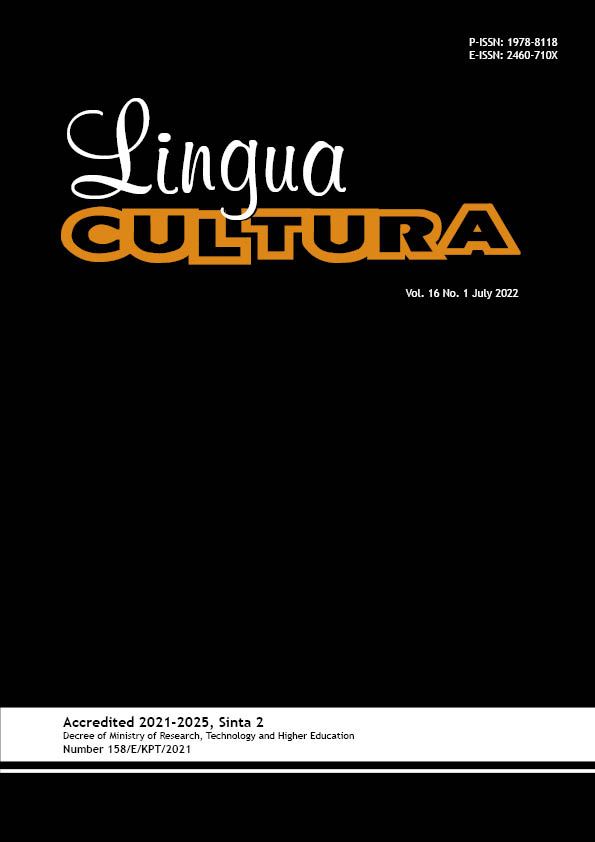A Contrastive Analysis of Chinese and Indonesian Nominal Sentences
DOI:
https://doi.org/10.21512/lc.v16i1.7770Keywords:
contrastive analysis, Chinese, Indonesian, nominal sentences, error analysisAbstract
The comparative study aimed to describe the characteristics of Chinese and Indonesian nominal sentences. The research contributed to teaching Chinese as a second language and the field of translation as well. Chinese was being studied all over the world, and Indonesia was no exception. Nevertheless, contrastive analysis between Chinese and Indonesian in the field of syntax were still limited. Nominal sentences are one of the classifications of sentences based on the predicate form. Accordingly, Chinese and Indonesian nominal sentences have similar definitions but differed in the words or phrases that form the predicate. The data in the contrastive analysis study were Chinese and Indonesian nominal sentences from short stories, novels, other literary works, and examples of related grammatical works. The data were analyzed using the James procedure and the contrastive analysis method with four steps described by Di Pietro. The finding of the contrastive analysis indicates that in both languages, nominal sentence usage is limited under certain conditions; some Chinese nominal sentences will become verb sentences when translated into Indonesian. Also, Chinese and Indonesian nominal sentences differ in their negative forms. The error analysis indicates that Indonesian students still lack knowledge of Chinese nominal sentences and characteristics.
References
Adiantika, H. N. (2020). Contrastive analysis between Indonesian and English declarative sentences. ELT in Focus, 3(1), 15-25. http://dx.doi.org/10.35706/eltinfc.v3i1.3695.
Alwi, H. (2003). Tata bahasa baku bahasa Indonesia (5th Ed.). Jakarta: Balai Pustaka.
Bochari, S., Basri, H., & Arid, M. (2019). The student’s error in forming nominal clause in complex sentence. IDEAS Journal of Language Teaching and Learning, Linguistics and Literature, 7(2), 354-367. http://dx.doi.org/10.24256/ideas.v7i2.1085.
Chaer, A. (2012). Linguistik umum (Edisi revisi). Jakarta: Rineka Cipta.
Gao, H. (2020). Jijin goushi yufa shijiao xia mingci weiyuju de kua yuyan yanjiu. Xiandai Waiyu, 43(4), 463-476.
Khansir, A. A., & Pakdel, F. (2019). Contrastive analysis hypothesis and second language learning. Journal of ELT Research, 4(1), 35-43. https://doi.org/10.22236/JER_Vol4Issue1pp35-43.
Li, Y. (1995). Xiandai hanyu shiyong yufa. Beijing: Jiaoyu Kexue Chubanshe.
Misdawati. (2019). Analisis kontrastif dalam pembelajaran bahasa. ‘A Jamiy: Jurnal Bahasa dan Sastra Arab, 8(1), 53-66. http://dx.doi.org/10.31314/ajamiy.8.1.53-66.2019.
Nur, T. (2016). Analisis kontrastif dalam studi bahasa. Arabi : Journal of Arabic Studies, 1(2), 64-74. http://dx.doi.org/10.24865/ajas.v1i2.11.
Qin, X., & Pratomo, W. (2019). Contrastive analysis of particles in Chinese and Indonesian language. Litera: Jurnal Penelitian Bahasa, Sastra, dan Pengajarannya, 18(3), 361-378. https://doi.org/10.21831/ltr.v18i3.24223.
Shalehoddin., & Roulina, S. (2018). Syntactical analysis on subject and verb usage in descriptive writing of eighth grade students at SMP Bhinneka Nusantara Batam 2. Anglo Saxon: Journal of the English Language Education Study Program, 9(1), 107-114. https://doi.org/10.33373/anglo.v9i1.1421.
Trihardini, A. (2020). Fonologi bahasa Mandarin untuk pemelajar Indonesia. Depok: PT. Rajagrafindo Perkasa.
Uktolseja, L. J., Sujaja, H., & Matinahoru, M. (2019). A contrastive analysis between English and Indonesian kinds of sentences. IJET: Indonesian Journal of English Teaching, 8(1), 54-61. https://doi.org/10.15642/ijet2.2019.8.1.54-61.
Xing, F. (2010). Xiandai hanyu. Beijing: Gaodeng jiaoyu chubanshe.
Xiong, Z., & Yu, S. (2018). Mingci weiyuju de jufa fenxi. Duiwai Hanyu Yanjiu, 17, 1-14.
Xu, X., Sang, Z., & Pang, J. (2021). Tiqu he jihuo moxing xia de hanyu mingci weiyuju yanjiu. Xiandai Waiyu, 44(4), 483-494.
Zhang, J., & Zheng, T. (2015). Zhan. Xiamen Daxue Xuebao, 1(227), 147-156.
Zhu, D. (2007). Yufa jiangyi. Beijing: Yinshuguan.
Downloads
Published
How to Cite
Issue
Section
License
Copyright (c) 2022 Ayu Trihardini

This work is licensed under a Creative Commons Attribution-ShareAlike 4.0 International License.
Authors who publish with this journal agree to the following terms:
a. Authors retain copyright and grant the journal right of first publication with the work simultaneously licensed under a Creative Commons Attribution License - Share Alike that allows others to share the work with an acknowledgment of the work's authorship and initial publication in this journal.
b. Authors are able to enter into separate, additional contractual arrangements for the non-exclusive distribution of the journal's published version of the work (e.g., post it to an institutional repository or publish it in a book), with an acknowledgment of its initial publication in this journal.
c. Authors are permitted and encouraged to post their work online (e.g., in institutional repositories or on their website) prior to and during the submission process, as it can lead to productive exchanges, as well as earlier and greater citation of published work.
USER RIGHTS
All articles published Open Access will be immediately and permanently free for everyone to read and download. We are continuously working with our author communities to select the best choice of license options, currently being defined for this journal as follows: Creative Commons Attribution-Share Alike (CC BY-SA)


















